Biology
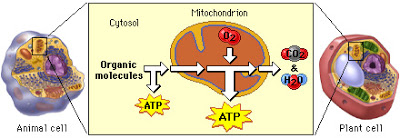 Respiration is the oxidation of energy-containing organic molecules. The energy released from this process is used to combine ADP with inorganic phosphate to make ATP.
Respiration is the oxidation of energy-containing organic molecules. The energy released from this process is used to combine ADP with inorganic phosphate to make ATP.
All cells obtain useable energy through respiration. Most cells use carbohydrate, usually glucose, as their fuel. Some cells, such as nerve cells, can only use glucose as their respiratory substrate, but others can use fatty acids, glycerol and amino acids.
Respiration may be aerobic or anaerobic. In both cases, glucose or another respiratory substrate is oxidised.
- In aerobic respiration, oxygen is involved, and the substrate is oxidised completely, releasing much of the energy that it contains.
- In anaerobic respiration, oxygen is not involved, and the substrate is only partially oxidised. Only a small proportion of the energy it contains is released.
Respiration of glucose has 4 main stages:
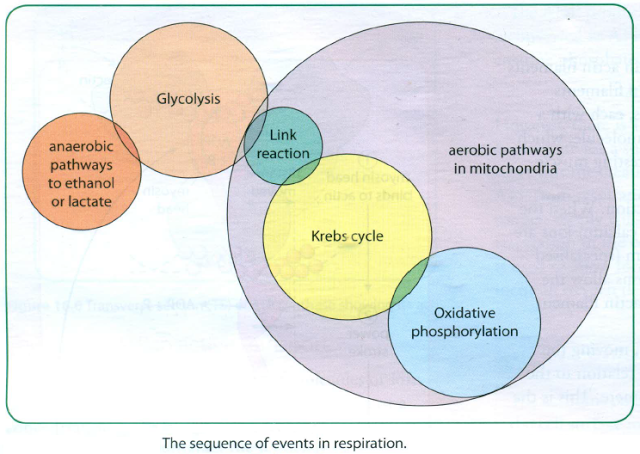
? glycolysis in the cytoplasm (cytosol) of the cell
? the link reaction in the matrix of a mitochondrion
? the Krebs cycle in the matrix of a mitochondrion
? oxidative phosphorylation on the inner mitochondrial membrane.
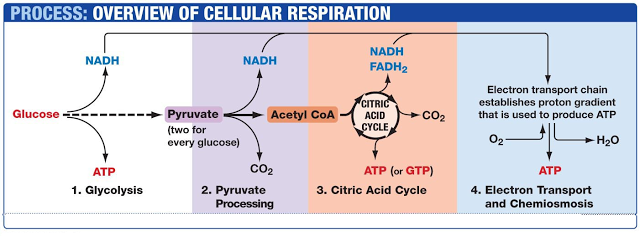
Glycolysis (the breakdown of glucose) is the first stage of respiration. It takes place in the cytoplasm and does not require oxygen. It begins with the 6-carbon ring-shaped structure of a single glucose molecule and ends with 2 molecules of a 3-carbon sugar called pyruvate and a net gain of 2 ATP. Glycolysis is summarised below.
? A glucose (or other hexose sugar) is phosphorylated, using phosphate from 2 molecules of ATP, to give hexose bisphosphate. This phosphorylation converts an energy-rich but unreactive molecule into one that is much more reactive, the chemical potential energy of which can be trapped more efficiently.
? The hexose bisphosphate is split into 2 triose phosphate molecules.
? Hydrogen atoms and phosphate groups are removed from the triose phosphate (by the coenzyme NAD). The removal of hydrogens is an oxidation reaction, so triose phosphate is oxidised to 2 molecules of pyruvate (pyruvic acid). During this step, the phosphate groups from the triose phosphates are added to ADP to produce a small yield of ATP.
? Overall, 2 molecules of ATP are used and 4 are made during glycolysis of one glucose molecule, making a net gain of 2 ATPs per glucose. The pyruvic acid is then converted to either lactic acid or alcohol and carbon dioxide without the production of any more ATP.
The pyruvate formed in glycolysis is still energy-rich. It passes next to the link reaction. This reaction and all subsequent stages of respiration occur inside a mitochondrion, and can only occur in the presence of free oxygen. Respiration requiring free oxygen is aerobic respiration. Pyruvate is transported into the mitochondrial matrix by a membrane transport protein, which exchanges it for OH? in the matrix.
Coenzymes
Respiration involves coenzymes called NAD and FAD. A coenzyme is a molecule required for an enzyme to be able to catalyse a reaction. Hydrogens removed during glycolysis are transferred to the hydrogen carrier molecule nicotinamide adenine dinucleotide (NAD) to give reduced NAD. The term 'reduce' means to add hydrogen, so reduced NAD has had hydrogen added to it. NAD is present in cells in small quantities and is continually recycled.

- Respiration
Respiration is the breakdown of large glucose molecules into simple molecules such as carbon dioxide and water with the simultaneous release of energy inside living cells. It is an enzyme mediated process. Main processes: Glycolysis (glucose to pyruvate,...
- Glycolysis
Glycolysis the breakdown of a glucose molecule into two pyruvate molecules. It is an example of substrate level phosphorylation. It occurs in the cytoplasm, whether in aerobic or anaerobic conditions. Glucose > Glucose-6-phosphate > Fructose-6-phosphate...
- #97 Summary Of Energy And Respiration
1 Organisms must do work to stay alive. The energy input necessary for this work is either light, for photosynthesis, or the chemical potential energy of organic molecules. Work includes anabolic reactions, active transport and movement. Some organisms,...
- # 91 Anaerobic Respiration - Ethanol And Lactate Pathways
Anaerobic respiration is a type of respiration that does not use oxygen. It is used when there is not enough oxygen for aerobic respiration. In the absence of free oxygen: Oxidative phosphorylation cannot take place, as there is nothing to accept...
- #85 Energy And Respiration - Syllabus 2016
12.1 Energy12.2 Respiration Energy is a fundamental concept in biology. All living things require a source of cellular energy to drive their various activities. ATP is the universal energy currency as its molecules are small,...
Biology
#87 Respiration, Glycolysis
All cells obtain useable energy through respiration. Most cells use carbohydrate, usually glucose, as their fuel. Some cells, such as nerve cells, can only use glucose as their respiratory substrate, but others can use fatty acids, glycerol and amino acids.
Respiration may be aerobic or anaerobic. In both cases, glucose or another respiratory substrate is oxidised.
- In aerobic respiration, oxygen is involved, and the substrate is oxidised completely, releasing much of the energy that it contains.
- In anaerobic respiration, oxygen is not involved, and the substrate is only partially oxidised. Only a small proportion of the energy it contains is released.
Respiration of glucose has 4 main stages:

? glycolysis in the cytoplasm (cytosol) of the cell
? the link reaction in the matrix of a mitochondrion
? the Krebs cycle in the matrix of a mitochondrion
? oxidative phosphorylation on the inner mitochondrial membrane.

AEROBIC RESPIRATION
Glycolysis
Glycolysis
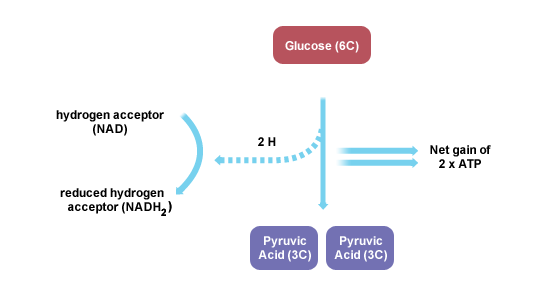 |
| Photo credit: BBC |
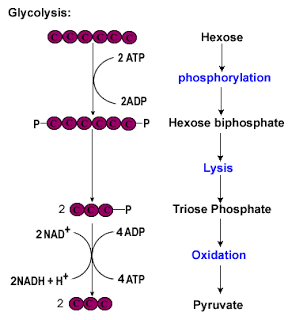 |
? The hexose bisphosphate is split into 2 triose phosphate molecules.
? Hydrogen atoms and phosphate groups are removed from the triose phosphate (by the coenzyme NAD). The removal of hydrogens is an oxidation reaction, so triose phosphate is oxidised to 2 molecules of pyruvate (pyruvic acid). During this step, the phosphate groups from the triose phosphates are added to ADP to produce a small yield of ATP.
? Overall, 2 molecules of ATP are used and 4 are made during glycolysis of one glucose molecule, making a net gain of 2 ATPs per glucose. The pyruvic acid is then converted to either lactic acid or alcohol and carbon dioxide without the production of any more ATP.
If the cell cannot catabolize the pyruvate molecules further, it will harvest only 2 ATP molecules from 1 molecule of glucose. For example, mature mammalian red blood cells are only capable of glycolysis, which is their sole source of ATP. If glycolysis is interrupted, these cells would eventually die.
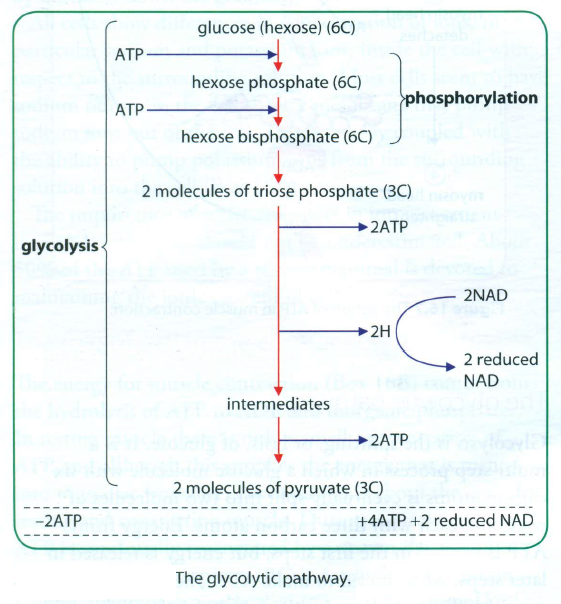

Coenzymes
Respiration involves coenzymes called NAD and FAD. A coenzyme is a molecule required for an enzyme to be able to catalyse a reaction. Hydrogens removed during glycolysis are transferred to the hydrogen carrier molecule nicotinamide adenine dinucleotide (NAD) to give reduced NAD. The term 'reduce' means to add hydrogen, so reduced NAD has had hydrogen added to it. NAD is present in cells in small quantities and is continually recycled.

Glycolysis ? Starting point : 1 molecule of glucose ? Products : 2 molecules of pyruvate, a net gain of 2 molecules of ATP, 2 molecules of reduced NAD. |
Syllabus: 12.1 Energy c) explain that ATP is synthesised in substrate-linked reactions in glycolysis d) outline the roles of the coenzymes NAD in respiration 12.2 Respiration Respiration is the process whereby energy from complex organic molecules is transferred to ATP. This process of ATP synthesis using the energy in proton gradients is common to both respiration and photosynthesis. Some organisms and some tissues are able to respire in both aerobic and anaerobic conditions. When yeast and plants respire under anaerobic conditions, they produce ethanol and carbon dioxide as end-products; mammalian muscle tissue produces lactate when oxygen is in short supply. a) list the four stages in aerobic respiration (glycolysis, link reaction, Krebs cycle and oxidative phosphorylation) and state where each occurs in eukaryotic cells b) outline glycolysis as phosphorylation of glucose and the subsequent splitting of fructose 1,6-bisphosphate (6C) into two triose phosphate molecules, which are then further oxidised to pyruvate with a small yield of ATP and reduced NAD |
- Respiration
Respiration is the breakdown of large glucose molecules into simple molecules such as carbon dioxide and water with the simultaneous release of energy inside living cells. It is an enzyme mediated process. Main processes: Glycolysis (glucose to pyruvate,...
- Glycolysis
Glycolysis the breakdown of a glucose molecule into two pyruvate molecules. It is an example of substrate level phosphorylation. It occurs in the cytoplasm, whether in aerobic or anaerobic conditions. Glucose > Glucose-6-phosphate > Fructose-6-phosphate...
- #97 Summary Of Energy And Respiration
1 Organisms must do work to stay alive. The energy input necessary for this work is either light, for photosynthesis, or the chemical potential energy of organic molecules. Work includes anabolic reactions, active transport and movement. Some organisms,...
- # 91 Anaerobic Respiration - Ethanol And Lactate Pathways
Anaerobic respiration is a type of respiration that does not use oxygen. It is used when there is not enough oxygen for aerobic respiration. In the absence of free oxygen: Oxidative phosphorylation cannot take place, as there is nothing to accept...
- #85 Energy And Respiration - Syllabus 2016
12.1 Energy12.2 Respiration Energy is a fundamental concept in biology. All living things require a source of cellular energy to drive their various activities. ATP is the universal energy currency as its molecules are small,...
